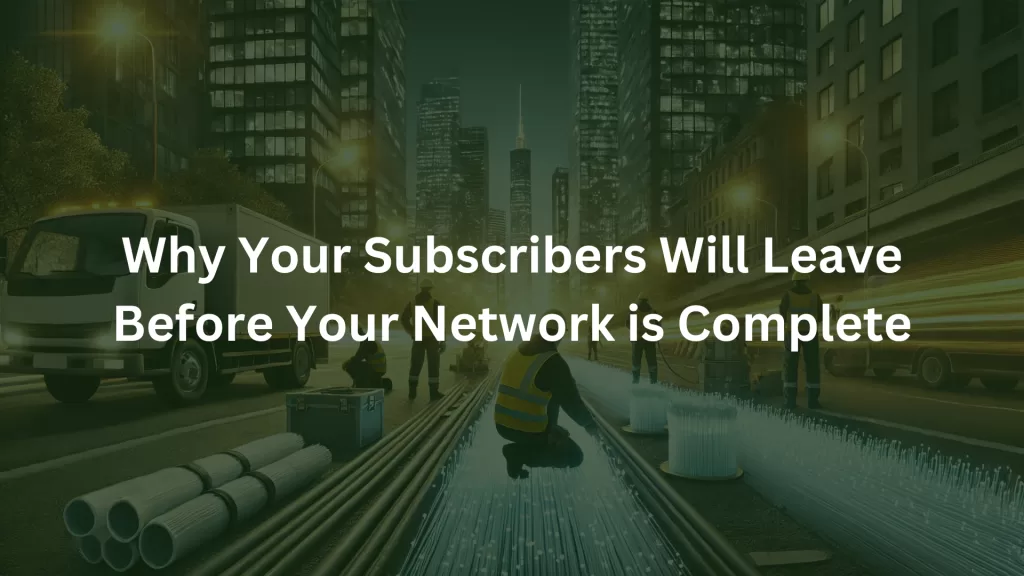
“Just six more months,” I assured the board, trying to keep my voice steady. “We’ll have Phase 1 complete by Q3.” As I said those words, I knew in my gut they weren’t true. We were already three months behind schedule, our take rate was falling short of projections, and my inbox was filling up with complaints from early adopters who’d been waiting over a year for service.
If you’re leading a fiber buildout, that scenario probably hits close to home. Because here’s the truth that keeps utility leaders up at night: your subscribers aren’t just buying fiber internet, they’re buying a promise. And when that promise gets broken, they don’t just get frustrated, they leave.
The Hidden Timebomb in Your Buildout Plan
Most fiber projects start with optimistic timelines and eager subscribers. But here’s what typically happens: You begin construction in high-density areas to get quick wins. Early adopters sign up enthusiastically. Your team celebrates the initial success. Then reality sets in.
Supply chain delays push timelines back. Crews hit unexpected underground utilities. Permitting takes months longer than planned. Meanwhile, those early sign-ups are watching and waiting. They’ve already mentally canceled their old service. They’ve told their neighbors about the amazing new fiber network coming to town. And now they’re stuck in limbo.
Here’s the costly mistake most leaders make: they assume subscriber patience is unlimited. But every delay chips away at trust, and every missed deadline pushes people closer to alternatives. One rural electric cooperative learned this the hard way when they lost 40% of their pre-registered subscribers after construction delays pushed their timeline back by eight months. Those customers didn’t just walk away – they signed multi-year contracts with competitors.
The real cost isn’t just in lost subscribers. It’s in damaged community trust, wasted marketing dollars, and the exponential effort required to win people back once they’ve lost faith in your project.
Why Traditional Approaches Make Things Worse
Look across the industry, and you’ll see a common pattern. Utilities and municipalities are approaching fiber deployments like traditional infrastructure projects. They’re using the same methodologies that worked for power lines and water systems. But fiber is different.
Traditional infrastructure follows a linear path: design, bid, build. But in today’s competitive broadband landscape, that approach is like trying to fill a bucket with a hole in it. While you’re methodically working through your phases, competitors are swooping in with fixed wireless. Satellite providers are marketing aggressive promotions. And your potential subscribers are making decisions that could lock them out of your network for years.
Let’s break down the real numbers:
- The average fiber project timeline slips by 35% from initial projections
- Marketing costs increase by 50-70% when trying to re-engage lost subscribers
- Customer acquisition costs triple when competing against entrenched providers
- Every month of delay reduces your ultimate take rate by 2-3%
These aren’t just statistics, they’re the difference between a thriving network and one that struggles to break even. I’ve seen board members go from enthusiastic supporters to skeptical critics as these realities set in. I’ve watched marketing teams burn through budgets trying to maintain momentum. And I’ve seen operations teams demoralized by constant schedule pressure.
A Better Way Forward
Think of fiber deployment like opening a restaurant. You wouldn’t build the entire restaurant before serving your first meal. You’d start with a soft opening, perfect your operations, and build your reputation while expanding. The same principle applies to fiber networks.
This is where Central State Utility’s approach makes a critical difference. Instead of treating fiber deployment as a linear construction project, we approach it as a subscriber-centric service rollout. Here’s what that looks like in practice:
First, we use advanced modeling to identify “success clusters” areas where we can quickly connect and satisfy groups of subscribers while building toward the larger network. It’s like creating micro-communities of happy customers who become your best marketers.
Our proprietary phasing methodology ensures that once we start in an area, we complete it quickly. No more partially served neighborhoods or frustrated subscribers watching construction crews pass by their street. One municipal utility using this approach maintained a 90% satisfaction rate even during an 18-month buildout by focusing on complete, rapid zone activation.
We also deploy specialized rapid-response construction teams that can adapt to changing conditions without disrupting the main construction schedule. When one cooperative hit unexpected rock formations that threatened to delay their schedule, our teams adjusted deployment patterns overnight to maintain momentum while engineering solutions.
The CSU Difference in Action
Consider what happened in Oklahoma when a member-owned cooperative. They had initially planned a traditional phase-by-phase buildout over 36 months. Instead, we helped them implement a dynamic deployment strategy that:
- Reduced the timeline to 24 months
- Maintained a 95% pre-registration conversion rate
- Achieved take rates 15% above industry averages
- Generated positive cash flow 8 months earlier than projected
We did this by treating every subscriber touchpoint as critical. From the moment someone pre-registers, they’re assigned to a specific construction milestone. They receive regular, accurate updates about their service date. And most importantly, we hit those dates.
Your Legacy Depends on These Decisions
The decisions you make in the next few months will impact your community for decades. This isn’t just about building a fiber network, it’s about building trust, maintaining momentum, and delivering on promises.
The path forward starts with a simple step: understanding where your current deployment strategy might be vulnerable. CSU offers a free deployment strategy assessment that can help you identify potential subscriber retention risks before they become problems.
Ask yourself: When your network is complete and your community is fully connected, what story will they tell about how you got there? Will it be about delays and frustration, or about a smooth transition into the digital future?
Let’s make sure it’s the latter. Your subscribers and your legacy deserve nothing less.
Want to learn how CSU can help ensure your subscribers stay excited and engaged throughout your entire buildout? Let’s talk about your specific challenges and how our proven approach can help you avoid the common pitfalls that delay success.
